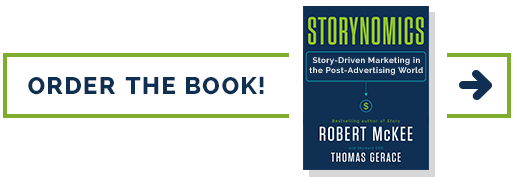Content Creation
Why First-Person Narratives and Personal Storytelling Work in Content Marketing
By Erin Ollila on April 4, 2018
My transition from creative writer to content marketer felt natural. Having focused on creative nonfiction in graduate school, I could weave first-person narratives easily. However, I soon realized that not all the brands I wrote for cared for using "I" or "we" in their content. But why?
Here's my best guess: Before storytelling took center stage in the marketing world, writers clung tightly to the rules of good ol' business writing, dictated by very specific stylistic choices. With the rise of digital content marketing, these rules have become more and more flexible. Personal storytelling is well-received by readers-but it's still foreign to many members of the marketing community.
Giving First Person the Opportunity to Shine
I have all the heart-eyes for writing with personal pronouns. Why? Well, I couldn't have written "I have all the heart-eyes . . ." without using one of them. Instead, you'd find me saying something to the effect of, "A person may have all the heart-eyes for writing with personal pronouns," which just sounds funny.
Image attribution: James Garcia
The more human we can be in our marketing efforts, the better our audience will connect with us. So why are some brands so hesitant to embrace the "I"? Personal pronouns create intimacy and authenticity. They ground readers in the present, even if you're discussing times past. Your content will read as more of a conversation and less of a textbook.
Our readers want to feel invited in. They want what they're reading to feel like someone is speaking to them. Plus, if they want to read something more dry, they always have the option to head over to a peer-reviewed journal and read about the newest scientific findings.
But there's more. When writers use first person, they're taking ownership of their opinions. There's no room for passive thoughts, relying on someone else's expertise, or being wishy-washy. When you bring the word "I" into a piece, you're asserting authority. The readers put their trust in what you're saying. They know that not only have you taken the time to think the thoughts but you've processed and edited them before committing them to the page. Plus-when you're backing up your own stories and claims with research, statistics, and interviews with professionals-your words will carry even more weight.
Bottom line-a first person narrative can do wonders for content marketing.
Convincing the Bosses to Adopt the "I"
Some marketing pros or members of the C-suite are hesitant to use personal pronouns in their content. Change is scary, especially for a well-known brand, and if what they've been doing is working for them, they may feel it's better to not rock the boat. However, that doesn't mean you can't make a case to at least try using a first-person narrative from time to time to see how it is received. One way to implement this would be to do a monthly (or ideally weekly!) series highlighting everyday influencers who are members of your brand's community. Whether completed as an interview series or essay writing, the introduction of their voices will be a natural transition to allow a personal perspective into your brand's content.
And if they are very hesitant, remind them that the use of first person doesn't need to read like a diary entry. Take the introduction to "5 Ways to Counteract Your Smartphone Addiction" by Larry Rosen in the Harvard Business Review as an example:
"We are living in an era of technology obsession and smartphone addiction. I hear it all the time: 'I can't go anywhere without my phone' or 'I feel anxious when I'm not able to check my email' or 'If I'm not on my social feeds, I feel like I'm missing out.'"
In just two sentences, Rosen uses personal pronouns eight times (eleven counting pronomial adjectives). Yet it doesn't come across as a personal tale. If you were to continue reading, you'd jump right into the research in the next few sentences.
What to Do If the First Person Is Off the Table
No matter how well you've stated your case for trying out the use of "I" in your content marketing, there's a chance it will remain off the table. So what do you do when you're trying to reach an audience? Choose not to write for them? No! Absolutely not. I write for a few brands who very seldom use a first-person perspective, and their content is excellent. While I'd argue the case for first person with anyone, there are many ways to embrace storytelling without involving yourself.
Embrace Your (Possibly Imaginary) Friends
If you can't write a first-person narrative, create a story that uses the same connection-building techniques. Tell the story of a real person. This works especially well if you're interviewing someone for the article. When you elevate the interviewee from a source to a main character, their story becomes just as important to the reader.
Image attribution: William Krause
Alternatively, you have the opportunity to create imaginary characters who will guide your readers throughout the piece. Let's pretend you're writing for a car sales company about what to look for in a mid-size SUV. You could introduce Sally, the busy mom who rushes from school pick-up to music lessons to baseball clinics (looks like it's going to be drive-thru fast food for dinner tonight!). Talk about her concerns for keeping her children (and most likely a few stray friends) safe. Discuss how she's trying to keep up her SUV lifestyle and is avoiding the mom-mobile van at any cost. Share her story, even if you're making Sally's life up as you go along. As long as you present her as a fictional character, your readers will engage with her story, with many finding commonalities between Sally's needs and their own.
Get Closer With the Use of "You"
When I can't utilize a first-person pronoun in my writing, my go-to is to employ the second-person perspective. While it doesn't do anything to make me look like a vulnerable, authentic writer, it allows the reader to play a significant role in what they're reading. "You" still allows for a personal connection between the reader and the writer. "You" makes them part of the story and not just an observer.
Kyle Harper, writing for the Content Standard, employs this technique in his article "The Anatomy of the Worst Brand Post on Reddit (And How to Get Reddit Marketing Right)." He starts it off by bringing in the reader immediately:
"Try for a moment to remember the worst mistake you've ever made at your job. Perhaps you accidentally posted a family photo meant for your Facebook wall to a brand page. Maybe an errant email campaign was sent to your suppression list rather than your target audience. You could even be one of the few unfortunate marketers to have their creative featured in a 'worst of' list at year's end. Whatever the case may be, you can rest (slightly) more easy at night knowing that the biggest Reddit marketing snafu has gone down in history without your name on it-at least for now."
He then goes on to tell the specific story of how EA Games managed to create the most downvoted comment in the history of Reddit. The story isn't about the time you messed up a marketing campaign at all. Yet, by drawing the reader in immediately, he forces readers to scroll through their own mental list of snafus committed before introducing EA's mishap of epic proportions. That invitation creates an investment for his audience to continue reading, which they will.
Are you trying to figure out how to reach an audience? Which perspective do you find yourself writing in most often-first, second, or third? Share your thoughts in the comments.
To learn more about brand storytelling, please see Storynomics, a book authored by Skyword CEO Tom Gerace and legendary story expert Robert McKee.

Featured image attribution: Thanh Tran


